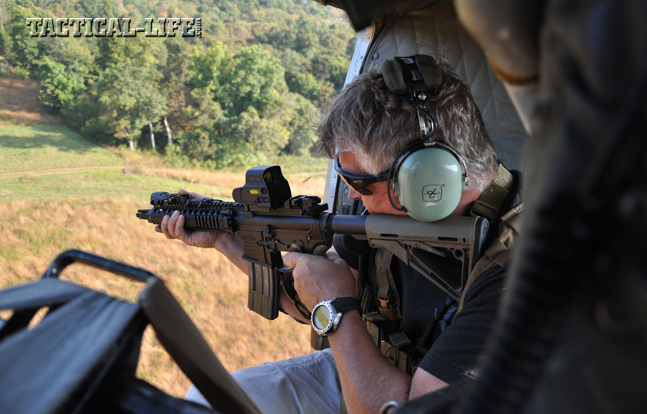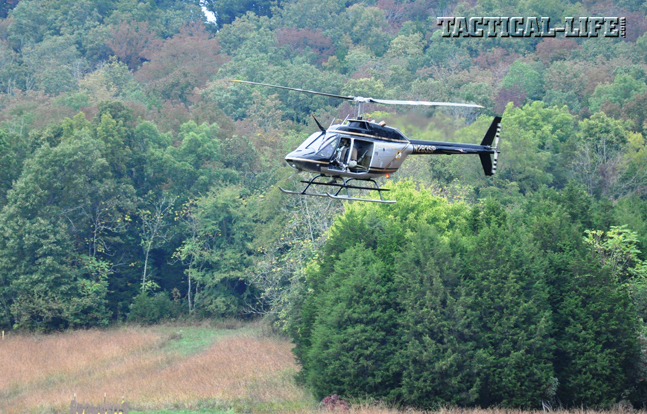I recently had the opportunity to attend a Helicopter Aerial Rifle Marksmanship (HARM) class that was held at the Rock Castle Shooting Center at Park Mammoth in Park City, Kentucky. The Rock Castle Shooting Center is made up of 2,000 acres of Kentucky countryside and is the site of the Mammoth Cave Sniper Competition and world-class 3-Gun matches. The event was hosted by the Kentucky State Police (KSP) Special Operations Branch, which contracted with Craft International to provide the training. Craft International reached out to Greg Coker and his company, Shield 91, to provide the instruction.
Coker spent over 20 years in the U.S. Army, with 15 of those as an AH-6 Little Bird pilot and an instructor pilot with the 160th Special Operations Aviation Regiment (SOAR). Coker is an exceptional pilot as well as a firearms instructor. This combination resulted in Coker developing the HARM program, which was validated and is currently in use by the U.S. military and several law enforcement units. Currently, Coker offers all sorts of real-world firearms-related training through his company, Shield 91.
Taking Flight
Advertisement — Continue Reading Below
The HARM program of instruction consists of classroom and ground instruction as well as live-fire exercises from an aircraft. While the emphasis is on marksmanship techniques needed to engage a target from a moving aircraft, Coker is quick to point out that mission success is dependent on the coordination between the shooter and the pilot. Successful engagements are equally dependent on both flying and marksmanship skills.
“Anytime a shooter boards an aircraft, he becomes a member of the aircrew…”
The initial ground phase of the training involves an in-depth briefing on flight profiles, safety procedures and the physics and ballistics of shooting from a moving aircraft. Options for rigging the aircraft and configuring weapons are also discussed in detail. Shooting at a stationary target from a moving platform, whether it is a boat, vehicle or aircraft, requires the shooter to aim behind the target. Instead of leading the target, the shooter “lags” the target. Coker presents this concept in a very clear and concise manner that is easily understood. Students are given a proprietary ballistics chart that gives the shooter the proper lag based on airspeed and distance.
Anytime a shooter boards an aircraft, he becomes a member of the aircrew, and a critical portion of the training involves integrating the shooter with the pilot and the co-pilot or observer. Coker’s 5,000-plus hours of flight time with the 160th SOAR and his easy-going personality give him instant credibility with law enforcement aviators. For the shooter to be successful, the flight parameters must fit within a specific profile. In essence, if the airspeed or distance is not what is called for, the shooter cannot be successful. Training flights start with a ground speed of 40 knots, an altitude of 100 feet and a range of 100 yards. Depending on the length of the course and range capabilities, profiles are increased to 60 knots with a range of up to 300 yards.
Advertisement — Continue Reading Below
Rigging the aircraft for the shooter involves both safety tethers and the use of a supporting sling. This can be as simple as attaching a D-ring to the shooter’s safety belt or involving the use of harnesses. The tether points are dependent on the model and configuration of the aircraft. Surplus aircraft, such as the OH-58 and OH-6, have hard points built into the floor of the aircraft. If commercial aircraft are used, seatbelt-mounting brackets or other hard points need to be identified prior to a mission. Coker prefers to have the shooter sit on the right side of the aircraft, directly behind the pilot. This enables the pilot and shooter to have the same line of sight on a potential target. This aids both communication and the positioning of the aircraft.
Fast & Accurate
Coker stresses, “We are responsible for every bullet we launch downrange!” The fact that the shooter is in an aircraft does not negate the legal responsibilities surrounding the use of deadly force. The preferred weapon for aerial platforms is the M4. The M4’s high magazine capacity and low recoil allows for rapid follow-up shots. In addition, .223 Remington/5.56mm NATO rounds will fragment when they strike most solid objects, minimizing the risk of collateral injuries from ricochets.
Advertisement — Continue Reading Below
“A proper sight picture, trigger control and a proper position are necessary to be successful…”
Coker’s optic of choice is a quality non-magnified red dot that allows the shooter to track and index the target with both eyes open. In addition, this type of optic enables the shooter to adjust for environmental conditions and lighting. Coker emphasizes that, regardless of the environment, basic marksmanship fundamentals are critical. A proper sight picture, trigger control and a proper position are necessary to be successful. Only semi-automatic fire is used in the HARM course.
The KSP Special Operations Branch includes the agency’s aviation unit and the Special Response Team, or SRT. The KSP SRT is a full-time team that has extensive experience working with the agency’s aviation unit. Their complete SRT unit attended the training along with officers from other agencies of Kentucky, Florida and Indiana. The SRT runs HK416 rifles equipped with Aimpoint optics, SureFire lights and PEQ laser units. The rest of the class used a variety of M4-type carbines with the exception of two officers who ran LaRue Tactical OBRs in 7.62mm/.308 Winchester. A few officers also ran SureFire sound suppressors, which eased the blast for both the shooter and the pilot. KSP’s aviation unit provided an OH-6 Little Bird and an OH-58 for the class.
The large range at Rock Castle allowed the placement of eight steel targets spaced between 75 and 100 yards apart. The initial training involved engaging targets using a barrel that was placed at a specific distance from the target. The barrel was used as an aiming point until students became accustomed to establishing the proper lag and follow-through. Shooters quickly learned to track the target early, keep the rifle moving and use a proper sight picture. We found that Coker’s dope chart was spot on, and all of the shooters achieved hits during the first evolution.
Advertisement — Continue Reading Below
In preparation for a real-world deployment, Coker suggested that students spend time getting measurements off common items to assist in judging lags during an actual deployment. Examples include the length of a F-150 truck or police vehicle and the width of a traffic lane. He also stressed the need for ongoing training and coordination between the officers and the aircrews.
Full Toolbox
It is important to note that aerial gunnery is not the same as a precision marksman or countersniper. While the hit ratio varied between shooters, by the end of the course hit ratios averaged about 80 percent. To quote Coker, aerial gunnery skills are “just another tool in the toolbox.” It is certainly not a tactic that is appropriate when the threat is located in a crowd of people. However, it is applicable to a threat that may be isolated or in an open space.
Advertisement — Continue Reading Below
Coker’s HARM class consists of proven techniques that are being employed by America’s elite Special Forces and multiple law enforcement agencies across the country. Agencies with aviation assets should consider an aerial gunnery program as well as Coker’s HARM training.
For more information, visit shield91.com.




































